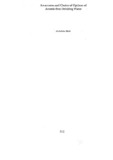Awareness and choice of options of Arsenic-free drinking water
Date
2000Publisher
BRAC Research and Evaluation Division (RED)Author
Hadi, AbdullahelMetadata
Show full item recordCitation
Hadi, A. (2000). Awareness and choice of options of Arsenic-free drinking water. Research Reports (2000): Social Studies, Vol – XXVI, 111–121.Abstract
The discovery of arsenic contamination in tubewell water has created concern for its potential health effects. BRAC
initiated an arsenic mitigation project in two upazilas in 1999. The project included promotion of community
awareness about arsenic contamination in drinking water and the demonstration of alternate safe water options
among others. This report assesses the contribution of BRAC initiative in raising awareness about arsenic problem
and identifies the choice of options for safe drinking water.
A combination of several methods s~ch as sample survey, in-depth interviews and focus group discussions
(FGDs) were used. The study was conducted in selected villages in Jhikargachha (project area) and Bheramara
upazilas (comparison area). A total of 1,240 randomly selected adult persons were interviewed. Arsenic problem
and its mitigation options were discussed with key stakeholders relevant to the project. In addition, the perception
of the users about options was understood through eight FGD sessions.
The term arsenic became well known in the remote communities where the tubewells were tested to
identify arsenic. The knowledge of safe water options was much higher in the project than comparison villages.
However, a very small proportion was aware of more than two options. The mitigation project was not only able to
significantly raise the awareness but also the knowledge of the signs and transmission of arsenicosis, it prevention
and sources of treatment.
The report assesses public perception about several safe water options that BRAC tested. No community
had all options together. The beneficiaries were given limited choices on the basis of which they could finally
select a mitigation option. It has become clear that each option had strengths as well as problems. Rainwater
harvesting, for example, was well known in the community but not preferred by most because of its seasonality
problem and odd smell of its water. The pond-sand filter (PSF) was a viable option although its distance from home
discourages many to use it. The main problem of Shafi filter was its maintenance and water containing capacity.
The dugwell water was reportedly visibly dirty and had health hazard. The maintenance of SIDKO filter was
proved difficult. The flow of water and the containing capacity of the lately introduced three-pitcher was
inadequate. However, considering price and privacy of its use, this option became very popular and acceptable to a
large community.
The study concludes that the community awareness of arsenic has significantly increased although the use
of safe water options was much less than expected. The main thrust of the project should, therefore, be shifted from
raising awareness to increase practice. Less preferred options should be discontinued in the subsequent phase of the
project. BRAC should think of providing more options in limited communities rather than limited choices in more
communities. The community played a very limited role in the mitigation process. The project can sustain only
when the users not only participate but own its success and failure. The role of key stakeholders of the project
should be clearly defined and their performance should be monitored. While tile project has provided valuable
insights about arsenic mitigation in a poor community, a number of issues have remained unsolved. The project,
therefore, should continue for some time.

